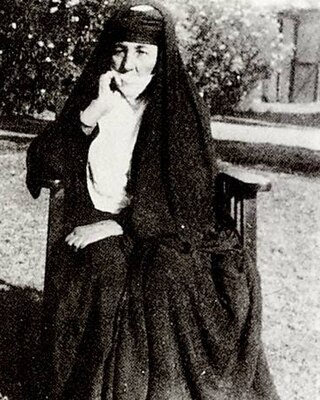This article needs additional citations for verification .(August 2019) |
The following is a list of notable persons of Yazidi descent.
This article needs additional citations for verification .(August 2019) |
The following is a list of notable persons of Yazidi descent.

‘Adī ibn Musāfir was a Sunni Muslim sheikh who is also considered a Yazidi saint. The Yazidis consider him as an avatar of Tawûsê Melek, which means "Peacock Angel". His tomb at Lalish, Iraq is a focal point of Yazidi pilgrimage.

Kurdish literature is literature written in the Kurdish languages. Literary Kurdish works have been written in each of the four main languages: Zaza, Gorani, Kurmanji and Sorani. Ali Hariri (1009–1079) is one of the first well-known poets who wrote in Kurdish. He was from the Hakkari region.

Lalish is a mountain valley and temple in Shekhan, Duhok Governorate in Iraq. It is the holiest temple of the Yazidis. It is the location of the tomb of the Sheikh Adi ibn Musafir, a central figure of the Yazidi faith.
Sheikh Sakhr Abū l-Barakat, was the nephew and successor of Sheikh Adi ibn Musafir, around whom the ‘Adawiyya order had formed. When ‘Adī died childless, Sakhr replaced him. He was executed by the Mongols in 1221-1222. He was succeeded by his eldest son Al-Hasan Ibn Adi.
Sheikh Hasan ibn Sheikh ‘Adī II is a holy and historical figure in that is revered in Yazidism and considered the physical or earthly incarnation of Melik Şêxsin, one of the Seven Divine Beings to whom God assigned the World's affairs. Melik Şêxsin is associated with the Pen and consequently with writing and books, he is thus called Xudanê Qelemê. Adani Sheikhs are the descendants of Sheikh Hasan and were traditionally the only ones in Yazidi society that had the privilege to acquire the art of writing and reading.

Sheikh Sharaf ad-Dīn ibn al-Hasan was the son and religious heir of al-Hasan ibn ‘Adī and thus head of the ‘Adawiyya order. He died in battle against the Mongols in 1258 and was succeeded by his uncle, Fakhr ad-Dīn ibn ‘Adī. Due to the hostility of the Mongols, his son Zayn ed Din preferred not to become his successor and passed on the duties to Fakhr ad-Dīn ibn ‘Adī, who was married to a Mongol.
Sheikh or Malak Fakhr ad-Dīn is a holy figure venerated in Yazidism, he is considered one of the Seven Divine Beings, to all of whom God assigned the World's affairs, and his earthly incarnation is considered one of the four sons of Ezdina Mir along with Nasirdin, Sheikh Shems, and Sejadin, who are the respective ancestors and patriarchs of the four Şemsanî Sheikh lineages and are considered to have been avatars of the angelic beings. Fexredîn is considered the personification of the Moon, while his brother, Sheikh Shems is the personification of the Sun.

Yazidis or Yezidis are a Kurdish-speaking endogamous religious group who are indigenous to Kurdistan, a geographical region in Western Asia that includes parts of Iraq, Syria, Turkey and Iran. The majority of Yazidis remaining in the Middle East today live in Iraq, primarily in the governorates of Nineveh and Duhok.

Bashiqa is a town situated at the heart of the Nineveh plain, between Mosul and Sheikhan, on the edges of Mount Maqlub.

Khurto Hajji Ismail was the Baba Sheikh of the Yazidis until his death in 2020. He held this position since 2007. He lived in Ain Sifni, Iraq.

Baadre (also written Ba'adra, Badra or Bathra, is a town located in the Shekhan District of the Ninawa Governorate in northern Iraq. The town is located in the Nineveh Plains. It belongs to the disputed territories of Northern Iraq. According to 2014 statistics, Baadre's urban population was 9 835 and the rural population was 5 167.

Mira Meyan Khatun or Mayan Khatun — Yazidi princess, a regent of Yezidi Emirate of Sheikhan in 1913-1957.

Tahseen Said or Tahsin Beg Saied was the hereditary leader of Yazidis. He was also the head of the Yazidi Supreme Spiritual Council and represented the Yazidis in all matters in respect of states and tribes. Although the historic base of the family is Ba'adra, Tahseen Said lived in the district capital, Ain Sifni.

Bozan is a village in Nineveh Governorate, Iraq. It is located in the Tel Kaif District in the Nineveh Plains and mostly inhabited by Yazidis.

The persecution of Yazidis has been ongoing since at least 637 CE. Yazidis are an endogamous and mostly Kurmanji-speaking minority, indigenous to Kurdistan. The Yazidi religion is regarded as "devil-worship" by Muslims and Islamists. Yazidis have been persecuted by the surrounding Muslims since the medieval ages, most notably by Safavids, Ottomans, neighbouring Muslim Arab and Kurdish tribes and principalities. After the 2014 Sinjar massacre of thousands of Yazidis by ISIL, which started the ethnic, cultural, and religious genocide of the Yazidis in Iraq, Yazidis still face discrimination from the Iraqi government and the Kurdistan Regional Government.
Sheikh Ali Ilyas is the Baba Sheikh of the Yazidis since November 2020.
There is a social organizational structure in the Yazidi community. There are three main castes, namely the Mirids, the Sheikhs, and the Pirs. Furthermore, there are positions for dignitaries in the Yazidi hierarchy.

Yazidism in Iraq refers to adherents of Yazidism from Iraq who reside mainly in the districts of Shekhan, Simele, Zakho and Tel Kaif, in Bashiqa and Bahzani, and the areas around Sinjar mountains in Sinjar district. According to estimates, the number of Yazidis in Iraq is up to 700,000. According to the Yazda aid organization, just over half a million Yazidis lived throughout Iraq before August 2014.
Alphabetical index of articles about the Yazidis, and their history and culture.